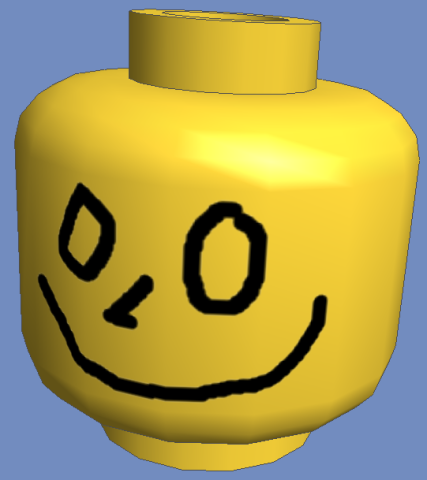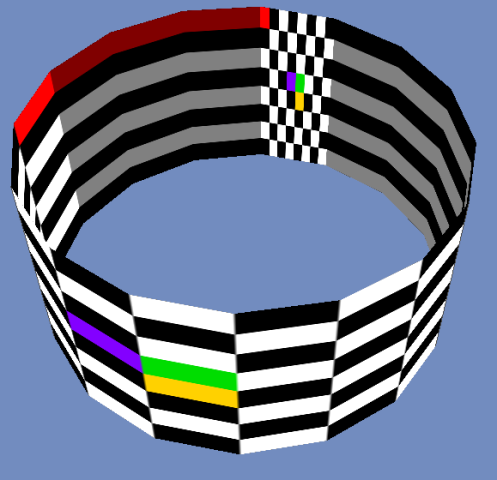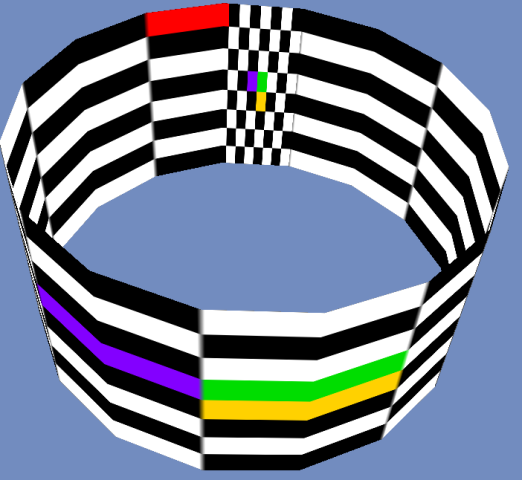TEXMAP extension thoughts and findings.
2014-08-07, 23:27 (This post was last modified: 2014-08-22, 4:46 by Benjamin Moody.)
2014-08-07, 23:27 (This post was last modified: 2014-08-22, 4:46 by Benjamin Moody.)
I've been working on the cylindrical implementation and I noticed some minor confusing things about the current TEXMAP spec.
The planar projection uses top/left orientation while the cylindrical one uses center bottom. This isn't a real big problem but the text states the v coordinate should be based on the distance to the base plane. This will cause the picture to be up side down.
So unless I misunderstood something (else) I think it should be the distance to the cylinder top plane.
Using that correction this:
will render like:

If people agree, we need to correct the spec text.
Second the spec doesn't mention what to do with over scan and or fully enclosed objects.
For example (using Nils' checker png ).
).
gives (over scan):

and
gives (enclosed)

Both having the -180 == 180 problem
But again i'm not claiming my implementation is currently 100% correct.
Thoughts?
The planar projection uses top/left orientation while the cylindrical one uses center bottom. This isn't a real big problem but the text states the v coordinate should be based on the distance to the base plane. This will cause the picture to be up side down.
So unless I misunderstood something (else) I think it should be the distance to the cylinder top plane.
Using that correction this:
Code:
0 Cyl texmap test minifig head
0 UNOFFICIAL PART
0 BFC CERTIFY CCW
1 16 0 0 0 1 0 0 0 1 0 0 0 1 s\3626bs02.dat
1 16 0 4 0 13 0 0 0 13 0 0 0 -13 1-8cyli.dat
1 16 0 4 0 -13 0 0 0 13 0 0 0 -13 1-8cyli.dat
1 16 0 4 0 13 0 0 0 13 0 0 0 13 2-4cyli.dat
1 16 0 4 0 0 0 8 0 -6.4 0 8 0 0 t04o6250.dat
1 16 0 4 0 -8 0 0 0 -6.4 0 0 0 8 t04o6250.dat
1 16 0 17 0 0 0 -8 0 6.4 0 8 0 0 t04o6250.dat
1 16 0 17 0 8 0 0 0 6.4 0 0 0 8 t04o6250.dat
1 16 0 4 0 0 0 -8 0 -6.4 0 -8 0 0 t04o6250.dat
1 16 0 4 0 8 0 0 0 -6.4 0 0 0 -8 t04o6250.dat
1 16 0 17 0 0 0 8 0 6.4 0 -8 0 0 t04o6250.dat
1 16 0 17 0 -8 0 0 0 6.4 0 0 0 -8 t04o6250.dat
0 !TEXMAP START CYLINDRICAL 0 17 0 0 4 0 0 17 -13 90 smile.png
0 !: 1 16 0 17 0 13 0 0 0 -13 0 0 0 -13 s\minifighead-hlp.dat
0 !TEXMAP FALLBACK
1 16 0 17 0 13 0 0 0 -13 0 0 0 -13 s\minifighead-hlp.dat
0 !TEXMAP ENDwill render like:
If people agree, we need to correct the spec text.
Second the spec doesn't mention what to do with over scan and or fully enclosed objects.
For example (using Nils' checker png
 ).
).Code:
0 !TEXMAP START CYLINDRICAL 0 0 0 0 -200 0 0 0 -200 180 checker.png
0 !: 1 15 0 -200 0 200 0 0 0 200 0 0 0 -200 4-4cyli.dat
0 !TEXMAP FALLBACK
1 15 0 -200 0 200 0 0 0 200 0 0 0 -200 4-4cyli.dat
0 !TEXMAP ENDgives (over scan):
and
Code:
0 !TEXMAP START CYLINDRICAL 0 0 0 0 -200 0 0 0 -200 360 checker.png
0 !: 1 15 0 -200 0 200 0 0 0 200 0 0 0 -200 4-4cyli.dat
0 !TEXMAP FALLBACK
1 15 0 -200 0 200 0 0 0 200 0 0 0 -200 4-4cyli.dat
0 !TEXMAP ENDgives (enclosed)
Both having the -180 == 180 problem
But again i'm not claiming my implementation is currently 100% correct.
Thoughts?
















 .
.